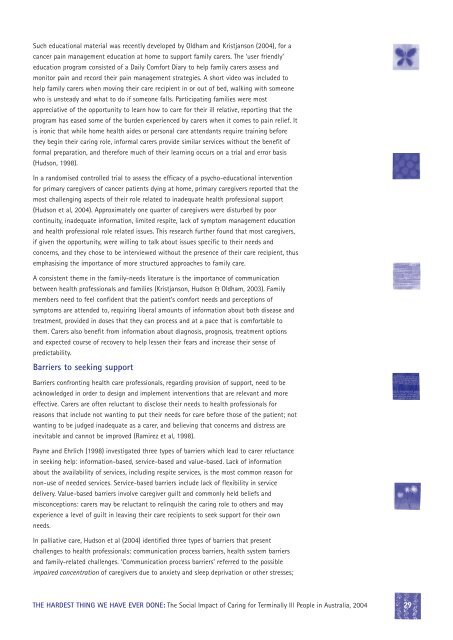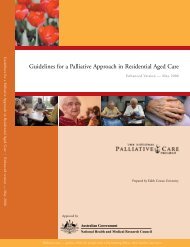The hardest thing we have ever done - Palliative Care Australia
The hardest thing we have ever done - Palliative Care Australia
The hardest thing we have ever done - Palliative Care Australia
You also want an ePaper? Increase the reach of your titles
YUMPU automatically turns print PDFs into web optimized ePapers that Google loves.
Such educational material was recently developed by Oldham and Kristjanson (2004), for a<br />
cancer pain management education at home to support family carers. <strong>The</strong> ‘user friendly’<br />
education program consisted of a Daily Comfort Diary to help family carers assess and<br />
monitor pain and record their pain management strategies. A short video was included to<br />
help family carers when moving their care recipient in or out of bed, walking with someone<br />
who is unsteady and what to do if someone falls. Participating families <strong>we</strong>re most<br />
appreciative of the opportunity to learn how to care for their ill relative, reporting that the<br />
program has eased some of the burden experienced by carers when it comes to pain relief. It<br />
is ironic that while home health aides or personal care attendants require training before<br />
they begin their caring role, informal carers provide similar services without the benefit of<br />
formal preparation, and therefore much of their learning occurs on a trial and error basis<br />
(Hudson, 1998).<br />
In a randomised controlled trial to assess the efficacy of a psycho-educational intervention<br />
for primary caregivers of cancer patients dying at home, primary caregivers reported that the<br />
most challenging aspects of their role related to inadequate health professional support<br />
(Hudson et al, 2004). Approximately one quarter of caregivers <strong>we</strong>re disturbed by poor<br />
continuity, inadequate information, limited respite, lack of symptom management education<br />
and health professional role related issues. This research further found that most caregivers,<br />
if given the opportunity, <strong>we</strong>re willing to talk about issues specific to their needs and<br />
concerns, and they chose to be intervie<strong>we</strong>d without the presence of their care recipient, thus<br />
emphasising the importance of more structured approaches to family care.<br />
A consistent theme in the family-needs literature is the importance of communication<br />
bet<strong>we</strong>en health professionals and families (Kristjanson, Hudson & Oldham, 2003). Family<br />
members need to feel confident that the patient’s comfort needs and perceptions of<br />
symptoms are attended to, requiring liberal amounts of information about both disease and<br />
treatment, provided in doses that they can process and at a pace that is comfortable to<br />
them. <strong>Care</strong>rs also benefit from information about diagnosis, prognosis, treatment options<br />
and expected course of recovery to help lessen their fears and increase their sense of<br />
predictability.<br />
Barriers to seeking support<br />
Barriers confronting health care professionals, regarding provision of support, need to be<br />
acknowledged in order to design and implement interventions that are relevant and more<br />
effective. <strong>Care</strong>rs are often reluctant to disclose their needs to health professionals for<br />
reasons that include not wanting to put their needs for care before those of the patient; not<br />
wanting to be judged inadequate as a carer, and believing that concerns and distress are<br />
inevitable and cannot be improved (Ramirez et al, 1998).<br />
Payne and Ehrlich (1998) investigated three types of barriers which lead to carer reluctance<br />
in seeking help: information-based, service-based and value-based. Lack of information<br />
about the availability of services, including respite services, is the most common reason for<br />
non-use of needed services. Service-based barriers include lack of flexibility in service<br />
delivery. Value-based barriers involve caregiver guilt and commonly held beliefs and<br />
misconceptions: carers may be reluctant to relinquish the caring role to others and may<br />
experience a level of guilt in leaving their care recipients to seek support for their own<br />
needs.<br />
In palliative care, Hudson et al (2004) identified three types of barriers that present<br />
challenges to health professionals: communication process barriers, health system barriers<br />
and family-related challenges. ‘Communication process barriers’ referred to the possible<br />
impaired concentration of caregivers due to anxiety and sleep deprivation or other stresses;<br />
THE HARDEST THING WE HAVE EVER DONE: <strong>The</strong> Social Impact of Caring for Terminally Ill People in <strong>Australia</strong>, 2004<br />
29
















